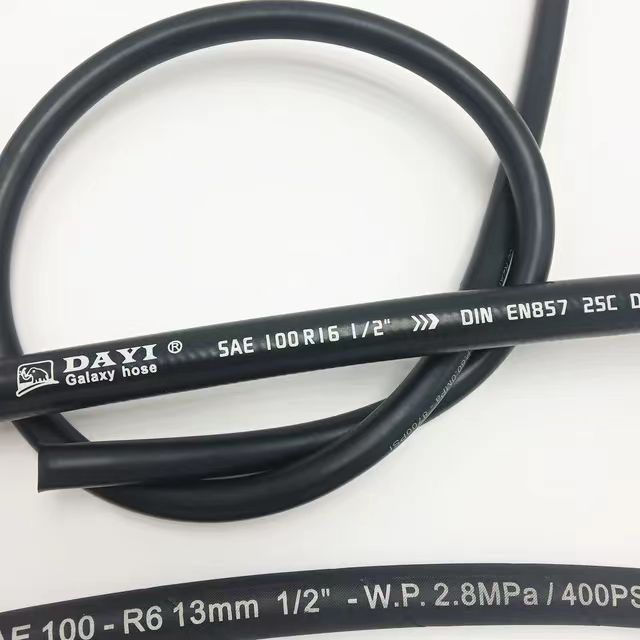12 月 . 03, 2024 19:03 Back to list
flexible high pressure rubber hydraulic hose factories
The Evolution and Importance of Flexible High-Pressure Rubber Hydraulic Hoses
In the realm of fluid mechanics, hydraulic hoses play a pivotal role in transferring hydraulic power effectively and efficiently between various components of machines and systems. Among the different types of hydraulic hoses, flexible high-pressure rubber hydraulic hoses are crucial in numerous industrial applications. This article delves into the evolution, manufacturing processes, and applications of these vital components, shedding light on their importance in modern engineering.
The Evolution of Hydraulic Hoses
The use of hydraulic systems can be traced back to ancient civilizations, but it was not until the 20th century that the hydraulic hose as we know it began to evolve. Early hydraulic systems utilized rigid pipes, which were prone to breakage and were difficult to install in spaces with limited accessibility. The introduction of rubber as a flexible material transformed the hydraulic hose industry. Rubber hoses offered the maneuverability and adaptability that rigid pipes could not provide, opening new horizons for the design of hydraulic systems.
Over the years, advancements in material science led to the development of high-pressure rubber hoses capable of withstanding extreme conditions. The incorporation of synthetic fibers and special rubber compounds enhanced strength, durability, and resistance to abrasion, temperature changes, and chemicals. Today, flexible high-pressure rubber hydraulic hoses are designed to handle pressures exceeding 4000 psi, making them suitable for a wide range of industrial applications.
Manufacturing Process
The manufacturing of flexible high-pressure rubber hydraulic hoses involves several critical steps. It begins with the careful selection of raw materials, including high-quality rubber compounds, reinforcement materials (like synthetic fibers or steel wire), and various additives to enhance performance characteristics.
1. Extrusion The rubber compound is heated and extruded to create a tubular shape. This initial step ensures the creation of a consistent and uniform hose wall.
2. Reinforcement Depending on the pressure requirements, layers of reinforcement materials are added. Braiding or spiraling steel wire around the rubber body is a common technique used to enhance the hose's strength and pressure resistance.
3. Curing The assembled hose goes through a curing process, also known as vulcanization. This involves heating the hose to allow the rubber to form chemical bonds, solidifying its structure and enhancing its properties.
flexible high pressure rubber hydraulic hose factories

4. Testing Before the hoses are released into the market, they undergo rigorous testing to ensure they meet industry standards for safety and performance. This includes pressure testing, abrasion resistance tests, and assessments for flexibility and durability.
5. Cutting and Fitting Finally, the hoses are cut to specific lengths and fitted with appropriate couplings or fittings to prepare them for installation in various hydraulic systems.
Applications of Flexible High-Pressure Rubber Hydraulic Hoses
Flexible high-pressure rubber hydraulic hoses are indispensable in a variety of sectors, including
- Construction Heavy machinery like excavators, loaders, and cranes uses hydraulic hoses to operate and control movement systems, showcasing the hoses' ability to withstand tough working conditions. - Agriculture Hydraulic systems in tractors and farm equipment rely on these hoses to manage their hydraulic operations effectively, offering precise control for various agricultural tasks.
- Automotive Industry In vehicles, these hoses are utilized in braking systems, power steering, and various other applications where reliable fluid transfer is essential.
- Manufacturing Many manufacturing processes utilize hydraulic hoses to operate equipment and machinery, significantly enhancing productivity and efficiency.
Conclusion
Flexible high-pressure rubber hydraulic hoses have evolved into essential components in various industries, owing to their durability, flexibility, and high-pressure capabilities. Their continued development and refinement are vital in keeping pace with the ever-increasing demands of modern engineering applications. As industries evolve and technologies advance, these hoses will remain a cornerstone of hydraulic systems, contributing to the efficiency and reliability of machinery across numerous fields. The future of hydraulic hose manufacturing holds promise, with innovations poised to further enhance their performance, ensuring they can meet the challenges of tomorrow’s applications.
-
EN857 2SC Hydraulic Hose Suppliers OEM & China Manufacturers
NewsMay.30,2025
-
51mm Hydraulic Hose Manufacturer China OEM Durable & Custom Solutions
NewsMay.30,2025
-
OEM Rubber Air Hose Supplier Durable Custom Solutions
NewsMay.29,2025
-
High-Pressure Wrapped Cover Steel Wire Spiral Hydraulic Hose Supplier
NewsMay.29,2025
-
Rubber water suction and discharge hose
NewsMar.07,2025
-
SAE 100 R6/EN 854 R6 Fibre Braided Oil Hose
NewsMar.07,2025



